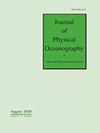盐度分层海洋的近惯性响应
IF 2.8
2区 地球科学
Q1 OCEANOGRAPHY
引用次数: 0
摘要
我们利用四个锚系设备六年的每小时观测数据,研究了盐度分层的孟加拉湾北部对季风影响的近惯性响应。表层风对近惯性混合层流的年平均能量输入为 10-20 kJ/m2,主要发生在 4 月至 9 月的明显的同步 "事件 "中。共分析了 15 个事件:其中 7 个事件发生在海洋被一层薄薄的低盐度河水覆盖的情况下(淡水),8 个事件发生在海洋没有被低盐度河水覆盖的情况下(咸水)。在淡水情况下,风输入的平均近惯性能量比咸水情况下高 40%。在淡水情况下,(A)混合层近惯性运动的衰减速度约为咸水情况下的两倍,(B)混合层下的近惯性动能比咸水情况下至少减少了三倍。测量了一次新鲜和一次含盐事件的近惯性水平波长;新鲜事件的近惯性水平波长比含盐事件短约三倍。根据这些数据调整的近惯性波传播线性模型再现了(B);在新鲜事件中,薄(10 米)混合层激发了高模,其传播速度比咸水事件中较厚(40 米)混合层激发的低模慢得多。该模式不能再现(A);新鲜事件中混合层惯性运动的快速衰减不能用解析尺度上的线性波传播来解释;很可能是一组不同的、目前未知的过程造成的。本文章由计算机程序翻译,如有差异,请以英文原文为准。
Near-inertial response of a salinity-stratified ocean
We study the near-inertial response of the salinity-stratified north Bay of Bengal to monsoonal wind forcing using six years of hourly observations from four moorings. The mean annual energy input from surface winds to near-inertial mixed-layer currents is 10–20 kJ/m2, occurring mainly in distinct synoptic “events” from April to September. A total of fifteen events are analyzed: Seven when the ocean is capped by a thin layer of low-salinity river water (fresh) and eight when it is not (salty). The average near-inertial energy input from winds is 40% higher in the fresh cases than in the salty cases. During the fresh events, (A) mixed layer near-inertial motions decay about two times faster, and (B) near-inertial kinetic energy below the mixed layer is reduced by at least a factor of three relative to the salty cases. The near-inertial horizontal wavelength was measured for one fresh and one salty event; the fresh was about three times shorter initially. A linear model of near-inertial wave propagation tuned to these data reproduces (B); the thin (10 m) mixed layers during the fresh events excite high modes, which propagate more slowly than the low modes excited by the thicker (40 m) mixed layers in the salty events. The model does not reproduce (A); the rapid decay of the mixed layer inertial motions in the fresh events is not explained by linear wave propagation at the resolved scales; a different and currently unknown set of processes is likely responsible.
求助全文
通过发布文献求助,成功后即可免费获取论文全文。
去求助
来源期刊
CiteScore
2.40
自引率
20.00%
发文量
200
审稿时长
4.5 months
期刊介绍:
The Journal of Physical Oceanography (JPO) (ISSN: 0022-3670; eISSN: 1520-0485) publishes research related to the physics of the ocean and to processes operating at its boundaries. Observational, theoretical, and modeling studies are all welcome, especially those that focus on elucidating specific physical processes. Papers that investigate interactions with other components of the Earth system (e.g., ocean–atmosphere, physical–biological, and physical–chemical interactions) as well as studies of other fluid systems (e.g., lakes and laboratory tanks) are also invited, as long as their focus is on understanding the ocean or its role in the Earth system.

 求助内容:
求助内容: 应助结果提醒方式:
应助结果提醒方式:


